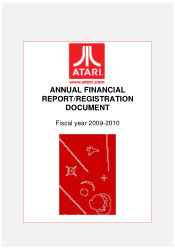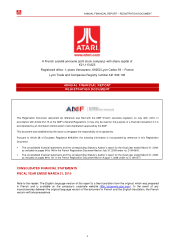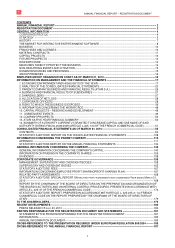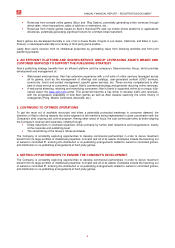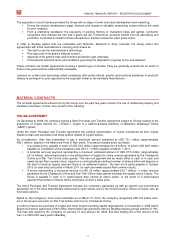Atari 2010 Annual Report Download - page 8
Download and view the complete annual report
Please find page 8 of the 2010 Atari annual report below. You can navigate through the pages in the report by either clicking on the pages listed below, or by using the keyword search tool below to find specific information within the annual report.
ANNUAL FINANCIAL REPORT – REGISTRATION DOCUMENT
8
December 2008 and brings together Atari’s distribution operations in Europe, Asia, Australia, Africa and New
Zealand.
• Acquisition in December 2008 of Cryptic Studios Inc., a leading MMO game creator, developer and operator.
2009
In January 2009, the Company issues bonds convertible into new or existing shares with warrants attached (ORANE-
BSA) with a nominal value of €40.5 million mainly to finance the acquisition of Cryptic Studios Inc. BlueBay entities
subscribe to 84% of the issue. As part of this transaction, the Company launches a simplified public exchange offering on
the bonds convertible into new or existing shares issued on January 4, 2008 (ORANE 2008) and the warrants issued by
the Company on September 22, 2006 and January 24, 2007 (2007 warrants).
In March 2009, the Company accelerates its transformation into a content-led online game company through Atari
Europe’s sale of its remaining 66% stake in Namco Bandai Partners to Namco Bandai Games Europe, by exercising its
put option. The transaction is completed in early July 2009.
In March 2009, Frank E. Dangeard is appointed non-executive Chairman of the Board of Directors.
In May 2009, the Board implements the Company’s corporate name change from Infogrames Entertainment to Atari. The
change had been approved by the Shareholders’ Meeting of September 25, 2008. This decision enables the Company to
make the best use of the Atari brand by capitalizing on strong worldwide brand recognition and customer loyalty – key
drivers to implementing the Company’s online, product and licensing strategies.
In May 2009, Jeff Lapin joins the Atari Group as Chief Operating Officer and is appointed CEO of the Company in
December 2009. Phil Harrison and David Gardner leave their operational functions respectively in May and December
2009.
In early July 2009, Atari completes the sale to Namco Bandai Games Europe of Atari Europe’s remaining 66% stake in
Namco Bandai Partners for a cash consideration of approximately €36.3 million.
2010
In January 2010, the Group completed a successful rights issuance, raising €43 million, netting approximately €30 million
of cash, after the conversion of a portion of existing debt to equity.
In April 2010, the Company strengthens its Board of Directors, with the arrival of two new members: industry veteran and
Atari founder Nolan Bushnell and online entrepreneur Tom Virden step in to further reinforce the strategic insight of the
Group.
THE MARKET FOR INTERACTIVE ENTERTAINMENT SOFTWARE
The interactive entertainment software industry primarily comprises software for dedicated game consoles or platforms
(such as PlayStation 2, PlayStation 3, Xbox 360 and Wii), handhelds (such as Game Boy Advance, Nintendo DS and
DSi and Sony PSP) and PCs. Publishers of video game software include console manufacturers, which publish games
for their own consoles, or "first-party publishers", and third-party publishers, such as Atari, whose primary role is to
develop, publish and distribute video game software for existing platforms. The online casual and social gaming
segment is the fastest growing part of the video game market. Additionally, the use of wireless devices (such as mobile
phones and smartphones) as a gaming platform, known as "mobile gaming", is growing rapidly.
The videogame market has been generally affected by the difficult economic situation, specifically depleted consumer
spending, ongoing since late 2008. According to International Development Group (IDG), an independent company
specializing in the analysis of statistical data in the fields of technology, media, etc., hardware and software revenues as
declined by 6% and 10% respectively in the US from the previous year and 18% and 14% respectively in Europe from
the previous year.
THE CONSOLE AND HANDHELD MARKET
Console platforms have made significant technological advances since the introduction of the first generation of modern
consoles by Nintendo in 1985. Hardware manufacturers have historically introduced a new and more technologically
advanced gaming console platform every four to five years. So-called portable consoles have also evolved since they
first came out, although the cycles have generally been longer (10 years for the portable GameBoy and 6 years for the
GameBoy Advance, versus 4 to 5 years for fixed consoles). With each new cycle, the customer base for video game
software has expanded as gaming enthusiasts mature and advances in video game hardware and software technology
engage new participants, generating greater numbers of console units purchased than in the prior cycle. The beginning
of each cycle is largely dominated by hardware (console) sales as consumers upgrade to the next-generation
technology.

